Risk Management Assignment: ERM Framework Of MPM Consulting Group
Question
Task: You will prepare two deliverables
1. An Enterprise Risk Management (ERM) Framework for the organisation;
2. A plan to implement the framework within the organisation.
The Risk Management Framework will cover the following elements:
- The outline and design of the ERM framework
- The organisational internal and external context
- Organisational roles, authorities, responsibilities and accountabilities, including allocated roles to support the framework
- How the framework will be reviewed and improved (frequency, method, documentation and responsibilities)
- Detail description of the risk management process (written as a guidance to users)
- Guidance on what is an acceptable level of risk
- Risk criteria tables (consequence, likelihood, and combined risk level)
- Risk register for use across the organisation
- A glossary of terms
- Agreement on the framework from the organisation’s governing body Some of these elements may be included in appendices (or attachments).
Answer
1.Introduction
The study of risk management assignment will be emphasized upon studying the preliminary risk management and enterprise risk management based on the standards of AS/NZS ISO 31000:2018 frameworks. Followed by, the focus will be laid upon discussing about the varied aspects the effects associated with the design of the ERM framework along with implementing the same within the MPM Consulting for determine its benefits, processes and guidance for the acceptable level of risks. Hence, the study will also be emphasizing upon the over viewing of the risk management process and the scopes that will be obtained by implementation of the framework for boosting the productivity of the consulting group.
2. Executive summary
The enterprise risk management assignment was designed to generate the strategic risk management plan for the MPM Consulting Group. The major objective of this report is to focus on risk management planning with the implementation approaches that support proper working possibilities to create better operation and business. On the other hand, maintaining the resources and structuring the assets also generates major support in constructing the idea of future association with critical business function management.
3. Part 1-Risk Management Framework
3.1. Outline and design of the ERM framework:
Enterprise Risk Management affects the entity of the organization like the management team, the administrative team, the external director and other personnel who applies strategy consisting of the idea of designed work approaches and future possibilities (Zhang, Long & Shi, 2015). The potential events and reasonable future assistance also need to structure in this segment so that the achievement of the organization can able to happen for MPM Consulting Group.
Standard of ISO31000:2018 risk management mentioned in risk management assignment follows the appropriate framework that consists with the idea of organization’s activities, projects, programs, operations and life-style. The different risk management principles, risk management process and risk management framework states the idea of proper management processing finds the appropriate pathway.
Design of the ERM Framework: MPM Consulting can take systematic approach which is required to identify and manage all operational risks. The process begins with risk identification using workshops, surveys, and risk registers. Once identified, managers need to systematically and accurately assess risks in terms of impact and likelihood. After identification and assessment, risks are clustered under any of the four techniques to manage risk avoidance, reduction, transfer and retention. The response to this challenge is to improve efficiency and develop work procedure for the organization.
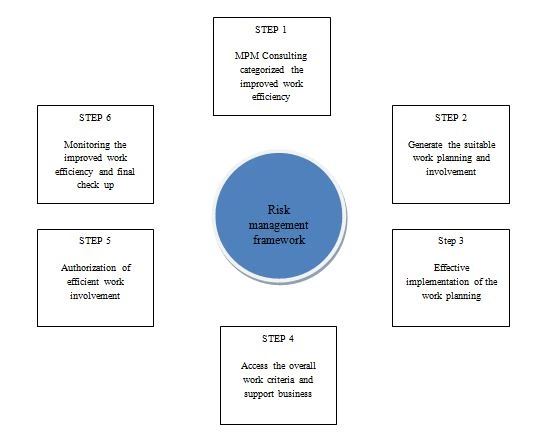
The risk management framework of the MPM Consulting has different segments that consider the corrective pathway to generate better idea about the future approaches and proper service direction.
STEP 1- The information system of the company categorized by high level of planning that directs the idea of project management planning to process with organizational system. The engineers, planners, drafters and designers are creating the effective work management criteria so that the project development and further information based development can able to generate in a better way (Modarres, Kaminskiy &Krivtsov, 2016). The company expansion has processed with the idea of creating variety of work approaches so that the financial context and further information can able to manage in this context of risk management assignment.
STEP 2- The work planning protocol of the company correctively focus on the long term development and progression systematically. The directive work planning and focusing on the market condition can provide the further information in these criteria.
STEP 3- The effective work management processing need to implement in an applicable manner for the MPM Consulting. The control deployment also need to structure in this aspect for the system management and environmental operation.
STEP 4- Assess the systematic way of working for MPM Consulting using appropriate procedures to determine the extent to which the controls are implemented correctly, operating as intended, and producing the desired outcome with respect to meeting the security requirements for the system.
STEP 5- Authorize system operation based upon a determination of the risk to organizational operations and assets, individuals resulting from the operation of the system and the decision that this risk is acceptable for the MPM Consulting.
STEP 6- Monitor and assess selected work assessment in the project need to structure properly. An ongoing basis including assessing security control effectiveness, documenting changes of the MPM Consulting to the system or environment of operation, conducting security impact analyses of the associated changes, and reporting the security state of the system to appropriate organizational officials
Maintenance of the framework: Risk Officer, Office Manager, the MD and the Board of Directors need to get the idea about the appropriate work processing focusing on work environment so that the continuous improvement can able to generate. The continuous improvement can generate the idea of current environmental assistance along with the budget related aspect as well. The staffs need to get the idea about the regulatory approaches and engage with the appropriate political assistance in an applicable manner.
Risk management principle: The risk management principles concentrate on the different activities and planning.
Organizational context- Follows the idea of political, legal, social, technological and societal approaches that has several risks.
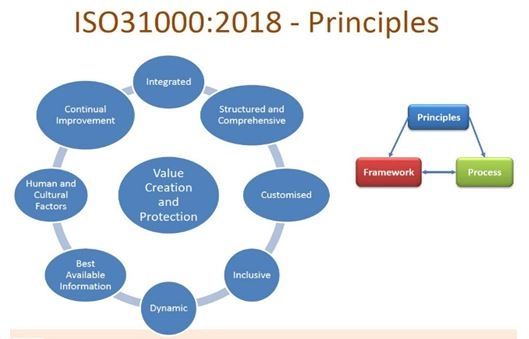
Figure 3.2: Risk Management principles
Source: Mehrjoo&Pasek, 2016)
Involvement of stakeholders- The stakeholders’ management and generating the idea of decision making context helps to create future development planning.
Organizational objectives- The organizational objective is to manage the proper assistance based on the future work approaches and involvement.
Reporting- Providing different information and engage with the directive work planning segment helps to initiate further activity processing.
Support structure- The corrective involvement and planning generates the major idea in accessing the responsive, dynamic and diligent approaches for change.
3.1.1 Risk management process and scope
MPM Consoling Group explored in risk management assignment has focused on the risk management process and scope so that the overall work prospect can able to generate in a coordinated manner. The ERP system based on AS / NZS ISO31000:2018 incorporate three segments like principle, process and framework. The employees, users and other audience need to constant the information based on the organizational requirement and focus on the proper idea for further action planning. The effective planning and implementation approaches follow the idea of systematic work association based on the suitable work implementation criteria.
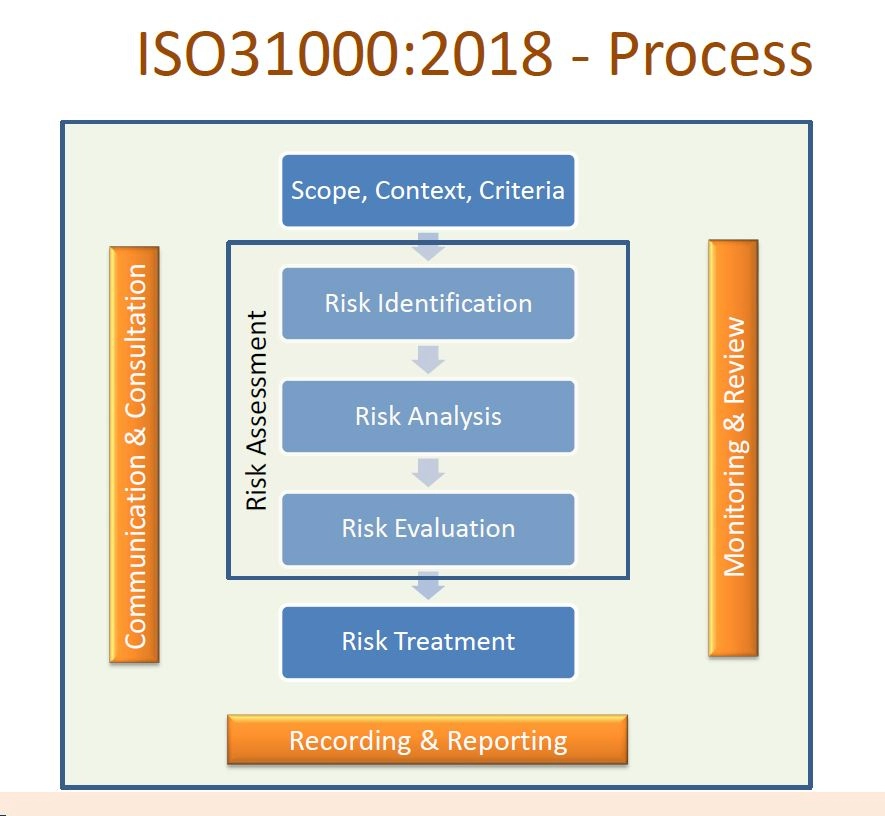
Figure 3.3: Risk Management process
Source: (Zhang, Long & Shi, 2015).
The risk management process consists of three parts: risk assessment and analysis, risk evaluation and risk treatment.
Risk Assessment & Analysis: The first step of the risk management process is called the risk assessment and analysis stage
Risk Evaluation: After the risk assessment/analysis has been completed, a risk evaluation should take place. A risk evaluation discussed in risk management assignment compares estimated risks against risk criteria that the organization has already established (Ellis & Lundy, 2016).
Risk Treatment & Response:
The last step in the risk management process is risk treatment and response. Risk treatment is the implementation of policies and procedures that will help avoid or minimize risks.
3.1.2 Identification of other organizational policies, strategies, and objectives
The organizational policy illustrated in enterprise risk management assignment consists of the idea of managing appropriate both internal and external work so that the future works advancement possibilities can able to construct. The development and growth assistance help to manage overall financial structure that connects with the applicable work management support that improves efficiency in the overall work to deliver the best result. Proper allocation of resources and managing viability, performance and reputation in this segment is a significant approach. The cooperative work approaches and integration also help to construct the proper accountability that supports long term work advancement planning (Zhang, Long & Shi, 2015).
Strategies- The different ERM related strategies that construct with the long-term competency management and interaction follows a suitable direction in this aspect.
- Generates rationalize risk management activities
- Managing any kind of uncertainties and creating the structured work approaches is constructed in this segment as well
- The ownership and responsibility management need to be structured by taking help of the proper evaluation and mitigation approaches
- Approval from the governing body for the ERM framework implementation
The objective of the organization consists of the idea of –
- Creating more efficient usage of resources and capital
- Constructing the idea of the reduced likelihood of any kind of operational loss
- Earlier detection of any kind of unlawful activities within the organization
- Cost-saving approaches while taking care of the various risk information, improvement procedure and streamline
3.2 Organizational internal and external context
The internal and external context of the organization connecting with risk identification and implementation consists of the idea of appropriate work management possibilities. The integrated view of risks and managing the planning-based awareness can generate major support in this segment so that the further work engagement can able to create systematically. The new structure of the organization follows the idea of civil division that supports the administrative approaches while taking care of the building divisions along with its approaches(Ellis & Lundy, 2016).
3.2.1 Internal Operating Environment
The mining division is also significant in this segment that helps to coordinate with the idea of electrical and mechanical engineering approaches. The environmental division and the civil division focus on the external work engagement and implementation approaches as well. The town planning division with the part-time economists and the designers is also effective in this segment as well. Managing and assisting the different stakeholders to the overall plan will help to generate proper aspect based on future needs. It will also correlate with the idea of generating better approaches based on the future progression of the organization. By being properly informed, the senior management and board can be proactive in responding to various risks and opportunities.
3.2.2 External Operating Environment
The construction organization followed the comprehensive risk identification planning with the assessment process, the credit unions need to identify the risk segments and will respond accordingly in this procedure (Henstra&Thistlethwaite, 2017). Enterprise risk management planning generates the idea of integrated supportive systems so that the applicable work possibilities and work involvement can able to structure in this segment of risk management assignment. Managing and building the appropriate planning and follows the compliance monitoring with the increasing awareness of the future work criteria can generate the major supportive consideration in this segment. The ERM structure helps to construct the future work assessment so that it can increase awareness and helps to create the culture of the organization with systematic work approaches.
3. 3 Organizational roles, authorities, responsibilities, and accountabilities, including allocated roles to support the framework
The key roles and responsibilities of the management and board need to be structured appropriately so that the risk management planning and integration can able to generate within time.
|
The board of director governs the risk profile with the other stakeholders |
Management takes suitable action that follows the proper way of a risk management plan with the acceptance level |
|
The implementation of ERM framework within the MPM Consulting needs to manage the supportive planning that gains assurance on the different work effectiveness |
Helps to develop the appropriate procedure so that the implementation approaches while managing the credit risks can be placed properly (Ellis & Lundy, 2016) |
|
Articulate the appropriate risks so that the future governing policies and approaches can able to construct within time |
Assigning the proper responsibilities to the civil division to take care of the corrective work specialization approaches based on the future necessities |
|
Gains the proper understanding based on the inherent and residual levels of risks in this segment |
The management of risk profile while taking care of the building division works that draw the mechanical and the electrical support to create appropriate division planning for the organization |
|
Understanding of the various gains that coordinate with the management work prospect while taking care of the risk responses as outlined through the planning |
The mining division helps to generate proper approaches based on the drafts that are made by the electrical engineers and the other drafters to experience the proper management planning and appropriate work engagement planning as well. |
|
Gains structural assurance to generate the proper outlines risk responses and possibilities that significantly adjust with the future work integration |
The commercial and the other industrial building experience for the gas, oil and mining procedure also need to structure in this segment of enterprise risk management assignment so that the applicable system assistance can able to generate in this prospect |
|
The environmental section helps to generate supportive environmental aspects as a small team to build the pragmatic work approaches |
Taking appropriate actions that helps to generate continuous and effective work management possibilities for future work integration |
|
The town planning segment associates with the small team that considers the external part-time economists, planning, and designers so that the overall management integration can able to construct in this aspect |
Presenting the periodic report that presents in the risk indicators and supports the work-related categories based on the supportive work approaches in a systematic manner |
|
The civil section helps the designers, engineers and the contract administrators so that the proper work engagement and planning can able to generate within time. |
Present information to the board of civil engineers to construct and create a particular idea based on future work assistance and planning |
3.4. How the framework will be reviewed and improved
ERM will be the on-going process for the organization that supports the senior management to corporate and generate proper assistance based on future work involvement. The effective five primary steps are engaged with the ERM process those are- reporting, risk identification, risk measurement and assessment, risk response and action and monitoring. The entire process requires the involvement of stakeholders along with the planning so that proper assistance and work management possibilities can able to construct in this segment (Ellis & Lundy, 2016). Significantly developing the risk appetite along with the tolerances also needs to establish as the senior management of MPM Consulting Group.
3.4.1 Frequency, method, documentation, and responsibilities
The risk framework will be reviewed by stating the determined work approaches while projecting the effective pathway based on the acceptable risk’s procedure and supportive work implementation structure. The specialists’ level and the executive level will be considered in this segment so that the risk management policies and strategies can able to generate in a better way (Barendrecht, Viglione&Blöschl, 2017).
The exact timeline and frequency of the review will be considered by focusing on the requirement of the organization. The significant management change and the coordinated work-based processing also help to generate major support in constructing the idea of more effective work processing criteria. The organization will involve with the individual department and its risks so that the structured work possibilities can able to generate in this segment of risk management assignment.
Assign correct responsibility to conduct the review
The risks function and further approaches concentrate on the idea of complete work management approaches that process with appropriate risk functionalities and work advancement structure (Yoon et al. 2019). The broad consultation manages to create proper integration based on the supportive decision-making approaches while taking care of the right outcome as well. MPM Consulting Group needs to manage the engineers and the external stakeholders in such a way so that the applicable work processing system can generate the major association in this prospect.
Establish the new scopes and method
While undertaking the review, it is important to construct the idea of effective communication that supports future work engagement planning.
- Adequately treat and control the residual and relevant exposures that need to control
- Regularly monitor and review the executives, board and the management planning (Taranu et al. 2017)
- Considers the organizational business process and planning
- Directs the systematic work advancement possibilities
Selection of the review type
- The internal audit process can serve the information
- Conduct the high-level review procedure
- Considers the Risk Management Policy,COSO principles, ISO31000 and peer entities
Determination of the approach
- The entities responses and planning need to structure properly
- Focuses on the current maturity of risks
- Focuses on the specific circumstances that are necessary to understand
Documentation process will provide the appropriate support that helps to create an appropriate plan while constructing the idea of completion of the activities (Mehrjoo&Pasek, 2016). The entire operation and management support in this context of enterprise risk management assignment are significant.
Plan: The proper execution of the plan and the accountable work authority processing helps to construct the future idea systematically. The terms of reference and planning, approach constructing survey and interview taking (MacMahon, McCaffery& Keenan, 2015). Any kind of communication-related issues needs to focus and plan for the proper coordinated service engagement planning.
Execution: Execute the plan while taking care of the different work advancement planning and generates the complete review procedure is an important approach. The document results and finding also construct a suitable integration in this procedure for the MPM Consulting.
Report and communicate
- The findings need to be drafted so that the proper recommendations can able to generate in this segment
- The company needs to share the information with the different stakeholders so that the suitable work approaches and guidance can able to construct in this procedure
- Finalize the report in a proper manner
- Issue the report to the senior management of the organization to take out information and audit the overall procedure systematically
The responsibilities will be placed on the audit committee members so that the overall information can able to channelize properly while taking care of the risk factors and mitigating the same correctively. Risk communication refers to the exchange of real-time information, advice and opinions between experts and people facing threats to their health, economic or social well-being.
3.5. Detailed description of the risk management process
The process of risk management consists of identification, monitoring and managing of the risks that are being identified present within the consulting organization and are -potentially leading towards disrupting the flow of works that are carried out. In context with the given scenario of the MPM Consulting Group discussed in risk management assignment, it was found that the organization formed during the year 2000 and within six months of its operating the organization with the small and medium size developers (Giannakis& Papadopoulos, 2016). However, along with making profit the organization during its expansion was found to be facing several threats with the continuous changing preferences as well as for mitigating the demands made by their customers. The MPM Consulting Group was required for implementing and adapt to using the new advanced technological systems and software’s in order to organize their tasks in an effective manner in order to accomplish the developed objectives within the given time frame. Therefore, being the project manager of the company and working part time as the risk offer the roles and responsibilities increased as wide areas required to be covered and monitoring all the tasks starting from the initiation, implementation of the plan until its completion was required to be monitored efficiently (Aven, 2016). Therefore, for understanding the processes adopted by the MPM Consulting Group in this enterprise risk management assignment in order to manage the risk has been adapted the framework of ERM along with maintaining the standards of AS/NZS ISO 31000:2018 risk management framework (Hopkin, 2018). The main components of this framework will take into consideration about the principle and the processes to be followed for mitigation of the risks present within the company. The identification of the risks is found can be categorised into two types such as the risks related to the uncertainty and the consequences based on the outcome of the same. Further, the uncertainty of the risks can be positively or negatively affect upon the decision making of the consulting group during its future working as well as based on the objectives that are being followed, attitude followed in terms of the disposition, state of mind and mental view.
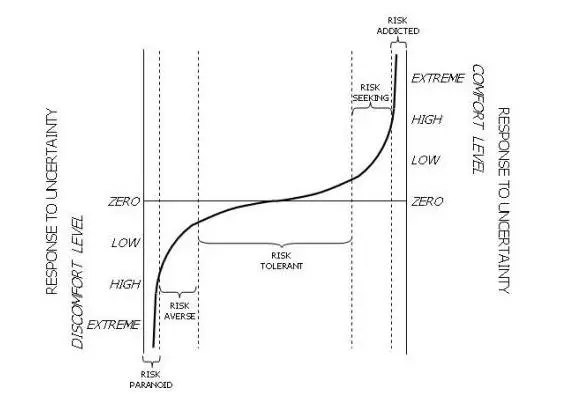
Figure 3.4:Risk attitude spectrum
Source: (Hillson& Murray-Webster, 2017)
The diagram, of the risk attitude spectrum helps in determining of the uncertain situations, which will elicit various attitudes that are preferred by the individuals belonging to different groups based on how the individuals perceive the uncertainties. The use of the risk, spectrum has been found to be leading to increase the capability of determining the level of the risk based on zero to extreme level, risk tolerance capacity along with the determination of the comfort level (Hillson& Murray-Webster, 2017). Reviewing of the issues it was found that the consulting company lacked proper methods for organizing and carrying out the activities that will be capable of fostering the growth and development of the company. The recent decision taken was found was found to be recruiting another director for the company, hence effectively monitoring as well as for organizing the pragmatic environmental scientist and guiding the planning division teams for execution of the designs in proper manner.
3.6. Guidance on what is an acceptable level of risk
The guidance of determining the acceptable level of risks can be observed with the help of implementing the Six A’s Model as this model helps in supporting the attitudinal changes that takes place within the process of work carried out within the respective organizations. Followed by, this particular framework implemented within the MPM Consulting Group will be beneficial as this framework is based on the theories of emotional intelligence, which helps in modification for including the feedback loop and the decisions that are being taken (Neuberger et al. 207). Therefore, the structured approach that can be evident from the Six A’s Model, for helping the groups or the personnel of the consulting group, consist of identifying the appropriate risk attitude within the given important as well as risky situations. Hence, the various aspects present within the Six A’s Model frameworks in enterprise risk management assignment can be described as follows:
- In the initial phase importance is laid for need for spreading appreciation and appreciation about the existing risks attitudes that are adopted and will be overcome by the groups of the individuals of the particular organization
- Secondly, the emphasis of this framework is given on the assessment for determination of the current risk related attitudes, which are likely leads towards acceptable outcomes to be obtained
- Thirdly, the importance has been given on the intervention that will be taken in order to mitigate or modify the prevailing attitudes related with the risks. In this step the process of assertion and the action are also found to be employed in order to make the necessary changes to be done
- Fourthly, the Six A’s model and its framework is advantageous for showing the existing risk attitude, which are appropriate and is associated with the and the current risk attitude that can be accepted
- This framework is also beneficial for denoting the importance e of the risk attitudes that can be accepted or modified depending on the current situation of the organization for monitoring or reassessing periodically for determining the interventions to be taken that will be able to resolve the issues that are occurring
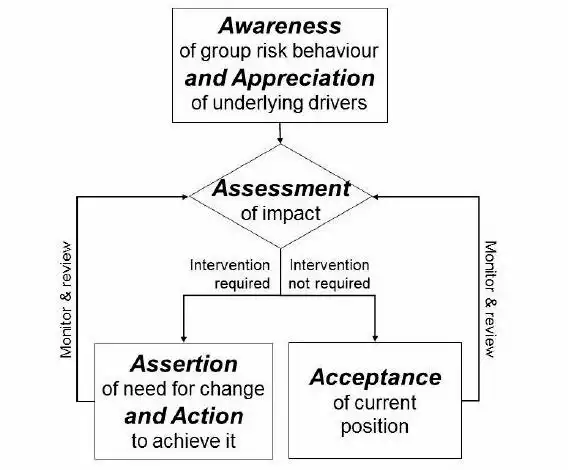
Figure 3.5: The Six A’s Model
Source: (Rosemann&vomBrocke, 2015)
Further, the data obtained from the study helps in determination of the aspects, which upheld the acceptable level of risks or tolerable on the basis, of whether the risks falls below an arbitrary defined probability or it falls below some of the levels, which can be tolerable. The risk will also be used whether the risk is falling below the arbitrary that are defined attributable fraction of total costs involved or exceeds the same (Watkiss, Hunt, Blyth &Dyszynski, 2015). The economic and political approaches are another important aspect required to be kept in mind in order to improve the decision making carried out by the organization for mitigation of the risks and facilitating a healthy working environment. Thus, after analysing the context of enterprise risk management assignment it can be said that the MPM Consulting Group, will be required to focus on the decisions that are taken during their expansion and facilitating services to their customers and satisfying them. The current risks were found occurring due to the changes made within the organizational structure and improper organizing of the projects inhibited however, the processes could be completed in an effective manner by considering the methods and adapting with the framework discussed for increasing the efficiency of the processes.
3.7. Risk criteria tables (consequence, likelihood, and combined risk level)
The identification of the potential threats or risks that are associated with the functioning of the MPM Consulting Group will be carried out by determining the likelihood and the consequences of the risks present with the help of the risk management framework. The assessment of risks thus refers to the process of calculating the magnitude of the potential consequences or the level of impact and the likelihood or the levels of probability of the consequences, which will be occurring. Hence, it is considered to be important for determining the risk criteria table for identification of the types of risk factors present within the functioning of the MPM Consulting Group and the likelihood class.
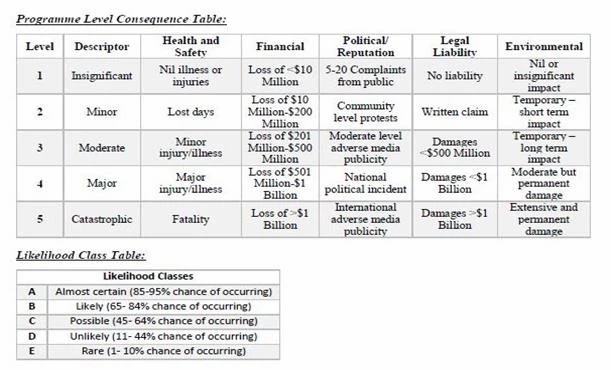
Figure 3.6: Risk consequences and likelihood
Source: (Meyer &Reniers, 2016)
Therefore, from the above table within this risk management assignment it can be observed that the level of risks are segregated on the basis of the level of the risks present within the health and safety, financial assets, political reputation, legal liabilities and environmental activities that are being carried out by the respective consulting firm. Hence, the consequences and the likelihood observed are discussed as follows:
- Health and safety: In context with the factor of health and safety, none of the individuals has faced any injuries and hence loss of the working days was minor. Moderate descriptor has been found in terms of minor illness and injury which took place. The catastrophic descriptor has been found to be fatality in this case.
- Financial aspects: The financial loss has been observed to be more than dollar ten million in the insignificant descriptor, the minor descriptor determiners that the loss of dollar ten million and within the range of two million will be taking place. Followed by, as per the moderate description assumes the loss can occur within the range of dollar five hundred one million up to dollar one million and according to the catastrophic descriptor the loss that will be made will be below dollar one billion has been found.
- Political/reputation: The risk consequences and the likelihood table in context of the political descriptor tend to highlight the fact that complaints reported were ranging from five to twenty forms the public, the minor descriptor denoted about the community level protests that may occur. Followed by, the moderate level of risks will be occurring from the adverse publicity of the existing media authorities. Along with this the major risks will be evolving with the national’s political incidents if occurs and the catastrophic risks may rise from the international adverse media publicity.
- Legal liability: The legal liabilities and the risks associated in this enterprise risk management assignment shows that insignificantly on the liability, which will be occurring. The written claim will be minor, damages will be less than a dollar five hundred million and the major risks associated with the damages will be more than dollar one billion as well as the catastrophic shows that damages will be less and hence the financial assets required will be less.
- Environmental: The environment risk associated according to the different descriptors is evident that risks will be nil, impacts will be short term based, long-term impact will be temporary, moderate of permanent damage have been found.
Thereby, it has been found from the likelihood class table that the cases which has a tendency of almost certain belongs within the range of eighty five or ninety five percent, chances of incidents that are likely to happen ranges from sixty five to eighty four percent and the possible chances ranges from forty five to sixty four percent. The unlikely occurring of the incident will be ranging from eleven to forty-four percent and the rare possibility will be ranging from one to ten percent only (Modarres, Kaminskiy&Krivtsov, 2016). Thus, the table can be considered important aspects within the risk management process for identification of the current status of the activities that are initiated and the risks which requires to be mitigated on immediate basis.
3.8. Risk register for use across the organisation
The main purpose of the risk register lies underneath the fact that the project managers for listing down the identified risks, clearly stating the same and assessing the risks accordingly, generally use it. The use of risk register is encouraged during the risk management processes in order to develop strategies or actions, which can potentially minimize as well as mitigate the risks in prosperous manner. Therefore, the importance of using the risk register with the MPM Consulting group will help in maintaining the stability towards resolving the identified risk. The appropriate communication, consultation, monitoring and review procedure has constructed the idea of creating applicable information based on the systematic work approaches. The annual revenue of the company is about $7mill. This will further help the consulting group to organize their tasks in order toeffectively carry out the internal and external processes.
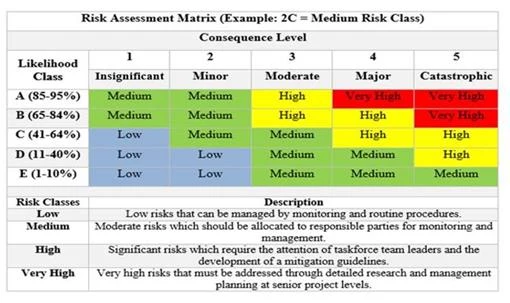
Figure 3.7: Combination of risk likelihood and consequences
Source: (O'Har, Senesi&Molenaar, 2017)
The table of the combination of risks associated with the likelihood and consequences has been represented as per the risks that are identified in the above section of risk management assignment. Hence, the risk register tends to highlight the importance and the potentiality of the risk factors in terms of very high, high, medium and low.
|
Date raised |
Risk description |
Likelihood |
Impact of risk occurs |
Severity |
Owner |
Mitigating action |
|
5.09.2019 |
Generates the appropriate planning based on the future organizational growth and development |
Medium |
Low |
High |
Project sponsor |
Focus directly on the systematic work planning approaches |
|
4.10.2019 |
Considers the different information from the stakeholders |
Low
|
Low |
High |
Project sponsor |
|
|
9.11.2019 |
State the further information consisting with the idea of future work engagement |
Low |
Low |
Medium |
|
Concentrating the effective planning and implementation approaches |
|
12.12.2019 |
Understand clearly about the long term development |
Low |
Low |
Low |
Project manager |
Develop the detailed idea about the future planning and implementation |
|
4.01.2019 |
Propose the future planning based on the current requirement |
Medium |
Low |
Low |
Project sponsor |
Assisting the long term work possibility that states the organizational requirement |
|
7.02.2019 |
Hold the applicable implementation structure |
Medium |
Low |
Low |
Project manager |
The project plan considers the idea of systematic implications based on the directive work criteria |
Table 3.1: Risk register and mitigation plan
The forming of the risk register in enterprise risk management assignment is thus, considered to be an important process within the risk management that has been initiated by the MPM Consulting group for increasing their working efficiency for gaining competitive advantage and satisfying their customers at the same time.
9. A glossary of terms
|
Terms |
Definition |
|
a. ERM
|
Enterprise risk management (ERM) is an effective plan based organizational strategy |
|
b. Risk Management Policy
|
The Risk Management Policy embedded with the idea of creating proper risk-based analysis that entities with some shared understanding |
|
c. COSO principles
|
The COSO model expresses internal control that formulates effective procedures and implementation plan |
|
d. ISO31000 |
It provides the proper guidelines, delivers principles, effective framework and a progression for managing risk |
Table 3.2: Glossary of terms
Conclusion
The completion of the study of risk management assignment helped in obtaining the data about the implementation of the risk management framework that are used by the MPM Consulting group. Therefore, the study has been able to prove deeper insights about the actions and the processes that should be taken by the MPM Consulting group for improving as well as enriching their way of working and facilitating satisfactory services to their customers. The study was further beneficial towards understanding the work carried out by the consultancy group for improving the internal as well as external risks, which tend to disrupt the process present within the organization. Further, the study is found to be advantageous for noting down the risk observed and determination of the likelihood depending upon the consequences for bringing transparency within the processes that are being initiated and maintaining the competitiveness of the company within the existing business environment.
4.Part 2-Risk implantation plan
4.1 Introduction:
This section of the enterprise risk management assignment attempts to offers an elaborate on the implementation plan that is aimed at addressing the risks identified in the previous risk assessment. The focus would lie at the integration an overall risk management plan with identified risks that are in terms of the budgeting of the plan.
4.2 Scope statements: The scope of the risk implementation plan is proper identification, analysis of the case, monitoring and control procedure that is ascertained to the probability of occurring. The degree of impact in this prospect is an important aspect that needs to measure to structure the schedule, cost, scope, and quality.
MPM Consulting Group in Brisbane, Queensland has seen growth after 6 months of the operation that follows appropriate administration and operation-based approaches. The organizational structure has also seen some changes to extend the services and profitability in the market (Hardesty & Wilcox, 2017). Building divisions and managing the appropriate work prospect helps to create further effective implementation and development. As a risk officer of the company, managing the various planning and mitigate different risks is the first and foremost segment in this aspect.
Benefits- The benefits of the risk management plan are easier to detect any issues in the project, the quality of decision making, communication prospect will be managed, the team will be guided properly, the expansion of the success will generate an appropriate budget management procedure will be constructed (Luo, Liu, Peng& Wu, 2018).
Outcome- The outcome will support the overall planning and implementation-based pathway so that the company can able to create its future development possibilities. Connecting with the probability and risk factors the effective risk mitigation planning will generate to create appropriate future assistance in this prospect (Griffin,Gaustad&Badami, 2019).
Success criteria- The success criteria will engage with the prioritized task of the organization, proper action planning, facilitation in decision making approaches, consider interactivity and appropriately aggregate the risks.
Objective The objectives are-
- To manage the specific goal is to focus on the effective risk management procedure
- To measure the different risks within the organization
- To achieve the effective risk planning and risk implementation procedure
- To access information based on the relevant resource and risk communication planning for future
- To consider the time bound involvement that considers the overall risk management planning
In and out scope- The proper risk management plan helps to generate supportive consideration based on the future planning and work advancement criteria. The team members will gather knowledge about the current condition of the organization and they will follow the planning properly. The deliverables of the enterprise risk management assignment concentrates on the identification, analysis, monitoring and control segment.
4.3 Project deliverables The project deliverables have input and output segments- Input- information, documents, plan equipment, money and software Output- Consultation, test results, tools, project plan, contracts and apps. Project management deliverables also include:
- Project Plan
- Reports
- Minutes
Constrains- the different constraints in the risk management planning is the change of schedule and some of the technical requirements as well. The technical requirements also can see some major changes considering the future planning and work association structure.
Assumption- Some of the risk tolerance that is acceptable or deemed needs to foresee and manage the overall procedure so that the engaged work-based possibilities can able to generate in this aspect (Poba-Nzaou, 2016). The risk related priorities and managing the applicable work integration systems also need to structure properly.
4.4 Illustrate strategy for implementation in enterprise risk management assignment The suitable risk management plan considers the resourcing, milestone setting, and procurement while taking care of the budget-related planning as well. The logic regarding the planning and supportive work approaches need to measure the overall outcome in this segment that specifies the future necessities as well. It will help to take out overall information based on the long term work planning while mitigating any issues from the project.
|
Activities |
1st month
|
2nd month |
3rd month |
4th month |
5th month |
6th month |
|
Planning a meeting |
|
|
|
|
|
|
|
Communication with stakeholders |
|
|
|
|
|
|
|
Construct the requirements |
|
|
|
|
|
|
|
Following infrastructural need |
|
|
|
|
|
|
|
Design the planning |
|
|
|
|
|
|
|
Initial testing |
|
|
|
|
|
|
|
Final implementation |
|
|
|
|
|
|
Table 4.1- Gantt Chart
The stakeholder management plan outlined in risk management assignment includes the appropriate action that follows the proper development and strategy based approaches while considering the potential result finding (Welch, Ismail &Masarip, 2018). The analysis of needs and interest of the stakeholders also construct the idea of creating a future pathway for the company.
4.5 Benefits of ERM to all stakeholders
- The director of the organization will help to generate a more risk-focused culture for the company
- The administrative department will be aware of the standardized risk reporting so that the effective system-basedimplication can generate further success
- The finance department will able to get appropriate support from the pre-budget planning segment by managing the risk perspective and integration
- The external director takes care of the efficient coordination of the compliance and regulatory approaches so that the advanced work procedure can able to construct in this segment (Ruan, 2017)
Reference List
Aven, T. (2016). Risk assessment and risk management: Review of recent advances on their foundation. European Journal of Operational Research, 253(1), 1-13.
Barendrecht, M. H., Viglione, A., &Blöschl, G. (2017).A dynamic framework for flood risk. Water Security, 1, 3-11.
Ellis, J. B., & Lundy, L. (2016).Implementing sustainable drainage systems for urban surface water management within the regulatory framework in England and Wales. Journal of environmental management, 183, 630-636.
Giannakis, M., & Papadopoulos, T. (2016). Risk management assignment Supply chain sustainability: A risk management approach. International Journal of Production Economics, 171, 455-470.
Griffin, G., Gaustad, G., &Badami, K. (2019). A framework for firm-level critical material supply management and mitigation. Resources Policy, 60, 262-276.
Hardesty, B. D., & Wilcox, C. (2017).A risk framework for tackling marine debris. Analytical Methods, 9(9), 1429-1436.
Henstra, D., &Thistlethwaite, J. (2017).Overcoming barriers to meeting the Sendai Framework for Disaster Risk Reduction.
Hillson, D., & Murray-Webster, R. (2017).Understanding and managing risk attitude.Routledge.
Hopkin, P. (2018). Fundamentals of risk management: understanding, evaluating and implementing effective risk management. Kogan Page Publishers.
Luo, F., Liu, Y., Peng, J., & Wu, J. (2018).Assessing urban landscape ecological risk through an adaptive cycle framework. Landscape and Urban Planning, 180, 125-134.
MacMahon, S. T., McCaffery, F., & Keenan, F. (2015, August). Development and validation of the MedITNet assessment framework: improving risk management of medical IT networks. In Proceedings of the 2015 International Conference on Software and System Process (pp. 17-26). ACM.
Mehrjoo, M., &Pasek, Z. J. (2016). Risk assessment for the supply chain of fast fashion apparel industry: a system dynamics framework. Enterprise risk management assignment International Journal of Production Research, 54(1), 28-48.
Meyer, T., &Reniers, G. (2016).Engineering risk management. Walter de Gruyter GmbH & Co KG.
Modarres, M., Kaminskiy, M. P., &Krivtsov, V. (2016).Reliability engineering and risk analysis: a practical guide. CRC press.
Nawaz, W., &Koc, M. (2018).Development of a systematic framework for sustainability management of organizations. Journal of Cleaner Production, 171, 1255-1274.
Neuberger, J. M., Bechstein, W. O., Kuypers, D. R., Burra, P., Citterio, F., De Geest, S., ...&Metselaar, H. J. (2017). Practical recommendations for long-term management of modifiable risks in kidney and liver transplant recipients: a guidance report and clinical checklist by the Consensus on Managing Modifiable Risk in Transplantation (COMMIT) Group. Transplantation, 101(4S), S1-S56.
Poba-Nzaou, P. (2016). Electronic Health Record in Hospitals: A Theoretical Framework for Collaborative Lifecycle Risk Management. Journal of Healthcare Communications, 1(2), 8.
Prewett, K., & Terry, A. (2018). COSO's Updated Enterprise Risk Management Framework—A Quest For Depth And Clarity. Journal of Corporate Accounting & Finance, 29(3), 16-23.
Rosemann, M., &vomBrocke, J. (2015). The six core elements of business process management. Risk management assignment In Handbook on business process management 1 (pp. 105-122).Springer, Berlin, Heidelberg.
Ruan, K. (2017). Introducing cybernomics: A unifying economic framework for measuring cyber risk. Computers & Security, 65, 77-89.
Taranu, Z. E., Gregory?Eaves, I., Steele, R. J., Beaulieu, M., & Legendre, P. (2017).Predicting microcystin concentrations in lakes and reservoirs at a continental scale: A new framework for modelling an important health risk factor. Global Ecology and Biogeography, 26(6), 625-637.
Watkiss, P., Hunt, A., Blyth, W., &Dyszynski, J. (2015). The use of new economic decision support tools for adaptation assessment: A review of methods and applications, towards guidance on applicability. Climatic Change, 132(3), 401-416.
Welch, C., Ismail, A., &Masarip, H. B. (2018, September). Creating a knowledge-pull framework for project-based risk management in the oil industry. In ECKM 2018: 19th European Conference on Knowledge Management. risk management assignment Academic Conferences and Publishing International Limited.
Yoon, I. K., Lim, D. Y., Jung, H. J., Seo, J. M., & Oh, S. K. (2019). A Supportive Framework for Collaborative Implementation of Quantitative Risk Analysis in the Hazardous Process Industry and Application to Natural Gas Plant. Journal of Chemical Engineering of Japan, 52(4), 349-361.
Zhang, Y., Long, J., & Shi, C. (2015). A comprehensive contingency management framework for supply chain disruption risk management. International Journal of Automation and Logistics, 1(4), 343-369.
Appendices
Image 1: Enterprise risk management cycle
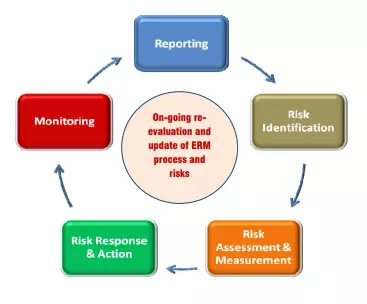
Image 2: Different risk categories
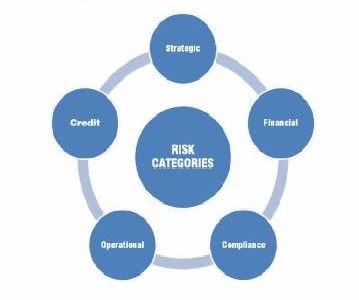
Image 3: Risk management cycle
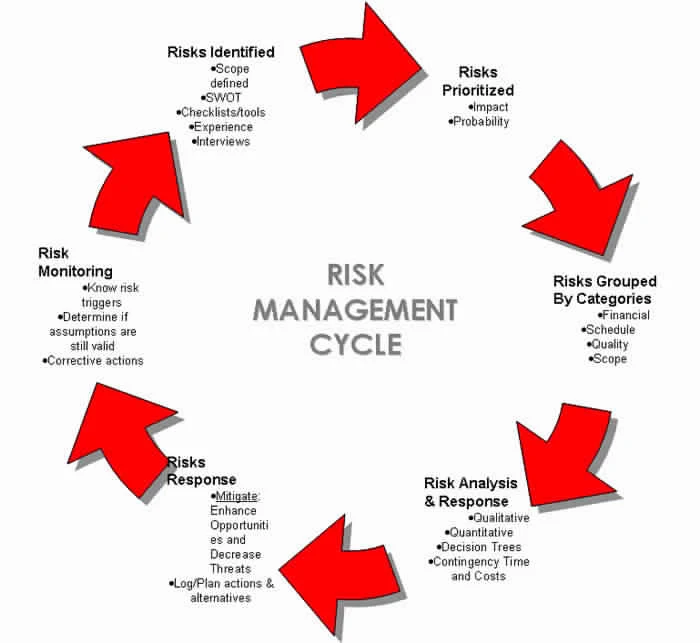
Get Top Quality Assignment Help and Score high grades. Download the Total Assignment help App from Google play store or Subscribe to totalassignmenthelp and receive the latest updates from the Academic fraternity in real time.












